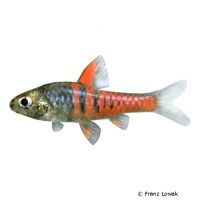Jae Barb (Enteromius jae)
| Jae Barb Enteromius jae | |
|---|---|
| Name | Jae Barb |
| Name Lat. | Enteromius jae |
| Synonym | Barbus jae |
| Family | Carps |
| Family lat. | Cyprinidae |
| Order | Carps |
| Order lat. | Cypriniformes |
| Origin | Africa |
| Habitat | Forest streams, swamps |
| Diet | Omnivore |
| pH | 5.0-7.0 |
| Behavior | Peaceful |
| Keeping | Group |
| Care Level | Moderate |
| Reproduction | Egg scatterer |
| Breeding | Moderately difficult |
| Life Span | 3-5 years |
| Protection | No |
| Metric Units | |
| Size | 3-4 cm |
| Temperature | 18-24 °C |
| Hardness | 1-5 °dH |
| Aquarium | 60 cm / 54 l |
| US Units | |
| Size | 1.2"-1.6" |
| Temperature | 64-75 °F |
| Hardness | 18-89 ppm |
| Aquarium | 15 gal |
Distribution and habitat
The distribution range of the Jae barb extends from Cameroon through Equatorial Guinea and Gabon to Congo. There they live mostly in small, vegetation-rich rivers and streams of the rainforests.
Maintenance
The aquarium should have a varied planting, which offers both shelters, as well as swimming space and roots, which serve as a retreat. In shaded light (floating plant cover) and dark substrate show the most beautiful coloration.
No ammonia, ammonium and nitrite should be detectable, the nitrate value should not exceed 100 mg/l. To ensure the water quality and oxygen content, a filter and heater adapted to the aquarium size is required, as well as lighting for the species-appropriate day-night rhythm of the animals.
Diet
They are problem-free in feeding. The food supply consists of live food, such as daphnia, cyclops, tubifex, artemia and black mosquito larvae, which are also eaten in frozen form without any problems, plus commercially available frozen special food mixtures, supplemented with high-quality dry food (flakes, granules). To cover their need for plant food, they regularly require crushed peas, mashed leafy and wild vegetables or dry food with high plant content (e.g. spirulina, kelp).
Regular and varied feeding promotes health and prevents deficiency symptoms. Only feed as much as is eaten immediately (in a maximum of 10 minutes).
Behaviour and compatibility
They are peaceful, agile schooling fish, which can be well socialized with other small and peaceful fish, better is the care in a species tank. At least 5, but preferably much more Yae barbs should be kept together.
Basically, only compatible fish species with similar demands on water condition and water temperature should be socialized
Sex dimorphism
Males are more intensely colored red, while females are more brownish.
Reproduction and breeding
The female spawns between dense, fine-textured plants (Java moss), usually in the early morning hours. The larvae hatch after about 40 hours and swim freely after 3-4 days.
Fry must be fed several times a day with special rearing food. In a community tank breeding is hardly possible, because the spawn is easy prey.
Important
Jae barbs do not tolerate temperatures above 24 °C for a long time. They then show increased susceptibility to diseases and age very quickly.
The well-being of the fish should be checked regularly. The temperature should be checked daily, the pH value, hardness and nitrate value at least every 14 days. Regular partial water changes are recommended, even if the pollutant load has not yet reached the upper limit. Sudden changes in water quality should be avoided. Newly introduced fish must be accustomed slowly to the water in the aquarium.
Further literature can be found in your pet store.
References
Text: petdata; Image: Franz Lowak
Source: BMELV (1998): Tierschutzgutachten - Haltung von Zierfischen (Süßwasser); BAENSCH & RIEHL (1997): Aquarien Atlas Bd. 5, Mergus Verlag; ENGELMANN (2005): Zootierhaltung - Tiere in menschlicher Obhut: Fische, Verlag Harri Deutsch
- Gemäß § 21 Abs. 5 Tierschutzgesetz idgF
